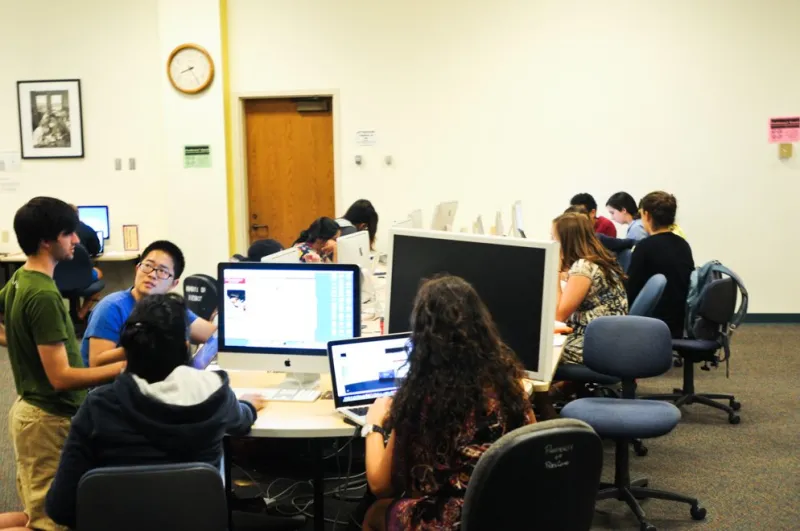As an act of community service during the COVID-19 pandemic, computer science professor Mehran Sahami ’92 M.S. ’93 Ph.D. ’99 and assistant professor Chris Piech ’10 M.S. ’11 Ph.D. ’16 will offer a shortened, online-only version of the introductory computer science course CS 106A to the public for free this spring. The class, which the instructors have titled “Code in Place,” will be taught in the programming language Python and is accepting applications from “anyone in the world” who is at least 18 years old and has access to a computer.
“This is a really tough time for a lot of people,” Piech said. “And we thought that for some people stuck at home, learning to code is not just reasonable, but might be a great thing to do; that could be students with intellectual curiosity or adults who want a new skill for the workforce.”
Ali Malik ’19 Ph.D ’25 is one of the many Stanford students involved in the project. COVID-19 presents educators with a unique chance to develop and improve virtual learning, Malik said.
“We have a huge opportunity to figure out ways that people can learn effectively online — ways that might be at odds with the traditional methods of online courses,” he said. “And at a time where people are on lockdown because of COVID-19, it seems like there could be a lot of impact in providing good learning resources.”
Code in Place is a one-time offering that will run for five weeks from April 13 until May 22. Enrollment will depend on scheduling availability and resources, and students will not receive a grade or credit for the class. Instead, Piech said, he hopes students will take the class for “the joy of learning”. To apply, interested individuals can complete a learning exercise that Piech and Sahami said they hoped would give applicants an “idea of whether this course is good for you” by the deadline of April 8.
“For the students, we are asking people to read a few pages and solve a few simple problems to find out who is really a beginner and who is going to put in the time for the course,” Piech said.
While the Stanford course CS 106A runs over the course of 10 weeks, Code in Place will cover material from the first half of CS 106A over five weeks. It will include four assignments. Piech and Sahami — who are also the instructors for CS 106A in spring quarter — said the class assumes no prior programming experience, but will require participants to spend 15 to 20 hours a week on course material, including streaming videos from their computers.
Though Code in Place offers video lectures every week, the instructors say that what distinguishes their learning experience from other free online coding programs is its “live interactive teaching” component. Enrolled students will learn and practice material through a 40-minute virtual meeting in small groups led by a member of the teaching team every week.
“Adding the section leading component to virtual learning gives it a human touch,” Piech said. “And this is what’s missing from some online education. You can participate in a chat room, but it’s not the same as a Zoom call with 10 other people who are going through the same experience with you.”
Malik also said the interactive component is important in online teaching.
“It breaks the pitfall of taking a faceless course where you are watching videos online, working in isolation and having to self-motivate and self-correct your understandings,” he said. “The invaluable role the section leaders play is that of a source of personalized guidance.”
The group of section leaders that make up the teaching team will include Stanford faculty, students, alumni and affiliates, but also educators and professionals across the globe who know Python and want to volunteer their time and expertise. Those who want to section lead can fill out an application by April 3.
“We’ve got people who are in the industry, people who have been teaching computer science for years and people who are retired but want to give back,” Piech said.
He hopes the project will also be beneficial to people who sign up to section lead.
“We have applicants from around the world who want to learn through teaching during this hard time,” Piech said.
To become a section leader, applicants will submit a teaching demo and solve a few coding problems to demonstrate knowledge of the subject and ability to guide others through the subject. However, Piech highlighted that individuals who do not have extensive teaching experience should also apply, as accepted applicants will go through several hours of training and learn from current Stanford section leaders.
“One of the things that we’re interested in is sharing the process of becoming a good teacher,” Piech said. “We have a lot of experience getting people to teach for the first time and now we really want to scale that know-how.”
“I hope we’ll come away from the experience having learned more about how to train computer science educators and make CS education more widely accessible beyond university settings and self-paced learn-to-program websites,” added Kylie Jue ’17 M.S. ’20, a former Daily editor.
Piech said the project is not the work of any one individual or role, but a community of people.
“This is the story of 100 people coming together to make this community-service project happen,” he told The Daily. “It’s a magical experience learning how to code. It changes how you think, how you see yourself, and what you’re able to do. That’s a gift we’ve all received and it’s a joy to pass that gift on.”
Contact Sarina Deb at sdeb7 ‘at’ stanford.edu.
